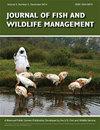模拟建模评估各种迁移情况下的线段距离采样
IF 0.9
4区 环境科学与生态学
Q4 BIODIVERSITY CONSERVATION
引用次数: 0
摘要
易位后监测方法的准确性对于评估易位计划的长期成功至关重要。易位会给监测工作带来独特的挑战,因此了解常用监测方法的灵活性和稳健性非常重要。在美国佛罗里达州,数千只地鼠龟已经(并将继续)从开发地点转移到允许的接收地点。由于软放生策略、生境条件和人口统计数据的差异,这些接收点创造了广泛的潜在监测场景。样线距离抽样(LTDS)是监测自然陆龟种群的有效方法,但目前尚未对迁移种群进行测试。因此,我们制作了3,024个基于个体的、空间明确的乌龟种群迁移场景,这些场景在接收地点和乌龟种群属性方面存在差异(基于现实世界的例子、文献综述和专家意见)。采用LTDS方法对模拟陆龟种群进行了虚拟采样,并建立了贝叶斯层次模型来估计每个模拟的种群密度,该模型包含了个体水平的协变量(即洞穴宽度和洞穴占用率)。样线距离取样法主要适用于地鼠陆龟接收地的典型条件;特别是当样线上的检测概率≥0.85时。设计相对于软放生围栏方向的横断面布局,以避免可能导致龟密度估计的极端异常值的抽样偏差,从而获得更准确的种群估计。我们还建议使用个人水平协变量,如本文所示,使用贝叶斯框架,可以提高LTDS调查在各种情况下的适用性,并且模拟可以成为评估复杂抽样情况下调查设计的强大工具。本文章由计算机程序翻译,如有差异,请以英文原文为准。
Simulation Modeling to Assess Line Transect Distance Sampling Under a Range of Translocation Scenarios
The accuracy of post-translocation monitoring methods is critical to assessing long-term success in translocation programs. Translocation can produce unique challenges to monitoring efforts, and it is therefore important to understand the flexibility and robustness of commonly used monitoring methods. In Florida, USA, thousands of gopher tortoises Gopherus polyphemus have been (and continue to be) translocated from development sites to permitted recipient sites. These recipient sites create a broad range of potential monitoring scenarios due to variability in soft-release strategy, habitat conditions, and population demographics. Line transect distance sampling (LTDS) is an effective method for monitoring natural tortoise populations, but is currently untested for translocated populations. We therefore produced 3,024 individual-based, spatially explicit scenarios of translocated tortoise populations that differed in recipient site and tortoise population properties (based on real-world examples, literature review, and expert opinion). We virtually sampled simulated tortoise populations using LTDS methods, and built a Bayesian hierarchical model to estimate the population density for each simulation, which incorporated individual-level covariates (i.e., burrow width and burrow occupancy). Line transect distance sampling was largely appropriate for the conditions that typify gopher tortoise recipient sites; particularly when detection probability on the transect lines was ≥ 0.85. Designing the layout of transects relative to the orientation of soft-release pens, to avoid possible sampling biases that lead to extreme outliers in estimates of tortoise densities, resulted in more accurate population estimates. We also suggest that use of individual-level covariates, applied using a Bayesian framework as demonstrated here, may improve the applicability of LTDS surveys in a variety of contexts, and that simulation can be a powerful tool for assessing survey design in complex sampling situations.
求助全文
通过发布文献求助,成功后即可免费获取论文全文。
去求助
来源期刊

Journal of Fish and Wildlife Management
BIODIVERSITY CONSERVATION-ECOLOGY
CiteScore
1.60
自引率
0.00%
发文量
43
审稿时长
>12 weeks
期刊介绍:
Journal of Fish and Wildlife Management encourages submission of original, high quality, English-language scientific papers on the practical application and integration of science to conservation and management of native North American fish, wildlife, plants and their habitats in the following categories: Articles, Notes, Surveys and Issues and Perspectives. Papers that do not relate directly to native North American fish, wildlife plants or their habitats may be considered if they highlight species that are closely related to, or conservation issues that are germane to, those in North America.
 求助内容:
求助内容: 应助结果提醒方式:
应助结果提醒方式:


